The Round Hill Society
The home site of the Round Hill Society, a community group of the residents of Round Hill in Brighton, England. The site contains information about the area, latest news and reflections on life in Round Hill.
This page is from the Round Hill Society archives which are available for historic interest. Please bear in mind when viewing archived pages that details may no longer be current.
Veolia 2013 hours Part 09
Veolia index | 1 | 2 | 3 | 4 | 5 | 6 | 7 | 8 | 9 | 10 | 11 | extension of hours
Records of nuisances from noise and odour [9 of 11] Recent incidents - May to July 2013
The nuisances are already well known and they result from the Dump's location - not from local residents' imaginations.
Noise nuisance is not so much a collection of "incidents" (as The Council's Senior Environmental Health officer likes to percieve it) but a "regular occurrence" while The WTS and The MRF are operating. Restricting operating hours (e.g. weekends, Bank Holidays, cut-off times before residents return from work) are the only methods of giving Hollingdean Depot's neighbours respite from a cocktail of unpleasant sounds which include: banging / echoing / rumbling within the MRF & WTS, glass-tipping, high-pitched hums / high pressure cleaning equipment / loud beeps from vehicles & machinery within the yard.
Odour nuisance appears to be impossible to prevent during hot spells i.e. the very weather conditions when residents most want to open windows or to be outdoors in their gardens.
De-sizing Hollingdean Depot (e.g. relocating the processing of food waste to a site which is far removed from people's homes & gardens) is the scale of solution needed.
The general problem with Hollingdean Depot is not only that the site is in an unsuitable location, but also space is really too tight for the mix of processing being done. This reflects the advice of the planning inspector who suggested split sites for the MRF & WTS during the public inquiry.
More space would facilitate (a) adequate landscaping and (b) sheds built to an adequate design standard (e.g. courtesy doors to allow satisfactory containment if the strategy is to neutralise the smelly paricles before they escape through open doors to be carried (often by the wind) into nearby streets & gardens and through open windows/doors into homes.
Noise nuisances - latter part of May 2013 GLASS TIPPING / INDUSTRIAL & VEHICLE NOISE ON SUNDAY & BANK HOLIDAY MONDAY - The afternoon of Sunday 26th May was interrupted by successive and very noisy instances of glass tipping which drove residents on the north side of Princes Road out of their gardens and behind shut windows when the weather invited outdoor leisure. Asked why there was noisy glass-tipping when delivery of glass on Sundays to Hollingdean Depot is contrary to planning conditions, Veolia said that the glass was merely being moved WITHIN THE YARD. The prolonged Sunday noise suffered by residents in nearby gardens & homes was indistinguishable from glass tipping accompanying delivery. We do not want to discuss semantics. We just need the protection of the clear condition intended by the planning officers outlawing these nuisances on Sundays and Bank Holidays. Indeed, the terms of Veolia's licence from The Environment Agency outlaws unreasonable levels of nuisance on ALL DAYS at ALL TIMES. Bank Holiday Monday 27th May saw similar weather conditions, but we were again driven indoors (when trying to spend lunch hour in the garden) by loud vehicle and industrial noise from the Hollingdean Depot Yard. Also unreasonable was the volume of noise in the early afternoon on Friday 31st May and the long session of continuous beeping from twenty minutes after midday on Thursday 6th June. The latter could easily be avoided through better site management.
Odour Diary 1st June - 20th July 2013We were notified by Veolia of a requirement for Saturday Working on 1st June 2013. Their letter, dated 31st May, also advised us that due to limited ability on Saturdays to transfer waste out to final disposal points on the same day, there could be some increase in odour. Indeed, the pleasure of the garden was spoilt by odour nuisance both on Saturday 1st & Sunday 2nd June. The odour nuisance remained on Monday 3rd June. A member of Veolia's staff (wearing yellow jacket) was seen doing a circuit around the northern border of Round Hill on the Monday morning so I assume the company know that they still have an odour management problem.
On finding the same wafts of odour being carried from the NE into my garden on Tuesday 4th June I lodged a complaint with The Environment Agency's incident hotline on 0800 80 70 60. I declined to rate the intensity of the odour on a scale of 1 to 6, instead saying that it was sufficient to warrant complaint. Frequency and duration are the other criteria used for assessing what is reasonable or unreasonable. I was dismayed that the odour still pervaded the garden late in the evening on Monday 3rd June, hours after operation at the WTS had stopped. Tuesday 4th was the last straw. But the odour nuisance made the use of our garden unpleasant through to the morning of Monday 10th June. Weather conditions were cooler, but significant reduction in odour only came towards midday, persumably after stored refuse rich in food waste had been moved out of The Waste Transfer Station.
The weather has remained hot through to mid July 2013. We were dismayed to be greeted again by strong odour from the Waste Transfer Station when we returned on 10th July 2013 from a few days holiday in the Peak District. I reported the nuisance to the environment agency then and my wife reported continued odour escapes from Hollingdean Depot on 12th July 2013.
Six days later, hot weather had not abated. Good smells are meant to come out of kitchen windows, but on 18th July 2013, wafts of Hollingdean Depot odour were entering ours.
I left watering the garden until between 9.30 and 9.45pm in the evening. I was dismayed to find that long after industrial activity had stopped, the same stale odour was lingering in the air amid the smell of my sweet peas. I emailed The Environment Agency about this when I came indoors just before 10pm.
As evening changed to night, it became quite windy. The combination of sun and wind helped to earn Round Hill its historical reputation as the city's drying fields. The direction of these winds is frequently from Hollingdean Depot right into our garden. Since Veolia's facilities started operating in 2009, summer watering of edible plants in our garden has had the secondary function of washing away small particles of dirt.
Saturday 20th July 2013 a cooler start to the day, but the sun soon comes up and wafts of odour from Hollingdean Depot continue to pervade my garden where I was from about 11am. My eyes soon feel the dust. By afternoon, the wind becomes evident and blows (mainly towards my house i.e. from NW to SE). The effect on my eyes is like spending too long in a congested area of London. I cut my first batch of sweet peas, glad to get them indoors. Hollingdean Depot needs a good clean.
Odour nuisance - the long "goodbye"
The unsuitable location of Hollingdea Depot has always come to the fore during periods of hot &/or windy weather.
The promised solutions for odour management trailed in newpaper articles have not proved remotely adequate. The Ultra Vioilet light system for zapping odour particles hyped in The Argus (3 Jan 2013) was never installed at Hollingdean Depot. It was never used because the Environment Agency considers it too dangerous to use where there are people around. Instead, Veolia is still using a deoderiser in an attempt to neutralise the odour particles - difficult to do in a building and yard which cannot contain them.
The Argus (3 Jan 2013) New technology to eliminate waste stations' stink
The Argus (22 Aug 2008) Hollingdean Dump kicks up a stink
The printed version of The Argus article on 3rd January 2013 New technology to eliminate waste stations' stink carried the headline: SAYING GOODBYE TO STATION'S STINK. The offerings from Hollingdean Depot in summer 2013 suggest that residents are in for a long "goodbye".
Noise Nuisance Diary - June / July 2009[resident living at the summit of Princes Road]
Sunday 28th June
10.33 11.20 WTS: tipping (door 2 open)
Monday 29th June
10.40 13.20 Very heavy use of WTS and MRF
11.12 11.15 Door of MRF left half open
12.18 Beeping from reversing siren of large open top truck
12.43 Tipping within WTS with door 3 open
12.53 Tipping (involving glass) within WTS: disruptive even though door is closed
13.04 13.10 More glass tipped. Prolonged banging and rumbling.
16.25 16.30 rumbling, tipping, banging from WTS heard in south-facing living room with all windows on the north side of the house shut
Wednesday 1st July
11.55 11.59 Tipping within WTS with door 3 open
Thursday 2nd July
15.05 Prolonged beeping from reversing sirens as Yull & Dod SWT lorry reverses clockwise round WTS
Wednesday 8th July
11.55 11.59 Tipping within WTS with door 1 open; reversing sirens; 3-vehicle queue outside MRF for long period = engine noise.
15.30 15.35 Rumbling and banging from WTS
Thursday 9th July
9.15 9.35 rumbling from WTS audible both from south-facing front upstairs bedroom and rear (north-facing) kitchen with the windows shut
10.13 10.15 Smell of rubbish (probably carried by wind) in air outside
Two lots of tipping involving glass in quick succession from WTS A very bad day, absolutely confirming that the level of noise associated with permitted operation of WTS has drastically reduced the quality of my recreation in my own home and garden. This does not rest on violations of operating rules. The doors of the WTS do not reduce the noise significantly. The buildings rumble.
10.30 More glass tipping while door 3 in the process of shutting. More rumbling.
10.55 Tipping within WTS with door 3 open
11.07 Tipping within WTS with door 2 open
11.12 Heavy rumbling
11.20 Tipping within MRF with doors open
11.33 Very noisy tipping (glass) with door 2 of WTS open
11.40 Heavy rumbling from WTS
11.42 More glass tipping within WTS
Too much disturbance in a single morning.
Monday 13th July
Much less intensive use. A much quieter day. Able to enjoy gardening. Thank you.
Tuesday14th July
11.20 Reversing sirens, engine noise and banging
14.45 Glass tipping To reduce disturbance, I closed rear bathroom window which I had opened for ventilation. Closing the bathroom door does not shut it out.
16.25 A lot of rumbling from WTS. Annoyance: rear windows have to remain closed.
NOTES
Although I have recorded breaches of operating conditions, the noise nuisance is the product of authorized operation. The noise of tipping is not greatly reduced by doors being correctly closed. The WTS/MRF sheds bang and rumble. Although my property is several times nearer geographically to the MRF, the main nuisance source is without any doubt the noise from the WTS. Smell has not proved enough of an issue to complain about during the period of these records (1 windy day with poor air quality including the smell of rubbish). Noise is a factor of the WTS and MRF being in normal operation. There is marked variation from day to day on how intensively the WTS and MRF are being used. There are ‘quiet’ days when the facilities are ‘tolerable neighbours’ and days when it is unpleasant to use my rear garden and when I am frequently disturbed even on the south side of my home with all the north-facing (rear / double-glazed) windows of my home shut.
Engine noise and reversing sirens become especially irritable when the MRF and WTS are being intensively used. Nuisance is experienced when lorries, which halt at the one-armed barrier at the entrance, need engine power to set themselves in motion again. Every time a vehicle sets itself in motion to go to the southern perimeter (door 14) of the MRF, the shunt of its acceleration is very audible. Very heavy vehicles bound for the WTS, set themselves in motion in the same way. They then stop and reverse into door 2 or 3 of the WTS. Not only does this multiply the engine noise of the lorries pulling away, but there is the noise of the reversing sirens as well. The issue of both reversing sirens and the exhaust systems used by lorries was raised with John Collis of Veolia during the Public Meetings concerning the WTS/MRF planning applications. I recall assurances being given.
However, vehicles using the WTS are of so many different types and appear to come from so many different places that it is difficult to understand how any standard assurance could be given or what measures could be taken to ensure that all reversing alarms/sirens emit tolerable ‘white noise’ more acceptable to the ear (i.e. what is called ‘broadband sound’ in the industry). If this is already an observed condition, then I would also query why so many of these vehicles are doing so much reversing (e.g. the Yull & Dod SWT lorry which entertained me on 2nd July with a symphony of ‘beeps’ while reversing clockwise around the WTS) when the WTS has so many different doors. It appears that reversing is the standard way to enter the WTS, as if the facility was especially designed to give maximum ‘siren and engine noise’ to local residents. It does not help that Hollingdean Depot amplifies noise like an ancient auditorium, something which residents living on the north side of Princes Road will confirm. Either the WTS was very badly designed or it has been decided to use the design with minimum regard to local residents. 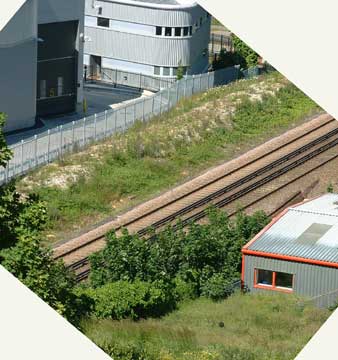 A mic has appeared on the greenfield site where Carelet wishes to house new residents opposite a Waste Transfer Station. But why is the developer's noise assessment being performed after the formal consultation period is over?
A mic has appeared on the greenfield site where Carelet wishes to house new residents opposite a Waste Transfer Station. But why is the developer's noise assessment being performed after the formal consultation period is over?
Assessing whether an area is fit for decent homes should be a developer's very first concern, before bothering to employ an architect. This is such an important area for comment that it warrants re-application. The site is not suitable for residential accommodation for factors which are being considered as afterthoughts. 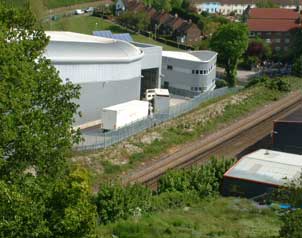 Veolia's WTS (N. of railway) and the greenfield site (S.) where Carelet wishes to create a 2nd building line: 4 houses with no street at the front.
Veolia's WTS (N. of railway) and the greenfield site (S.) where Carelet wishes to create a 2nd building line: 4 houses with no street at the front.
The proposed back gardens (new residents' amenity-space) would face the WTS.
Below: Waste Transfer Station from rear of the residential properties (north side of Princes Road from a distance. Carelet proposes to house new residents right opposite the main lorry entrance to both WTS and MRF!) 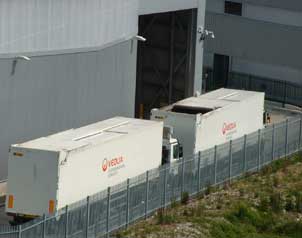
Following feedback I gave to Alison Walters about what life is like near a Materials Recovery Facility, I have had several complaints, which I fully endorse, on (a) 'Saturday working' during a bank holiday weekend, not after one, as permitted in condition 5, (b) on the growing nuisance of noise experienced by residents on both sides of Princes Road and (c) on the smell of rubbish experienced by residents living to the N and NE of Princes Road. I am especially concerned at the effects on noise levels and health when the entry and exit doors of Veolia's industrial units remain open for prolonged periods of time. This is happening now with the MRF. My back garden overlooks the entry door(s) of the MRF, but a long convoy of vehicles entering would also have to exit. I therefore expect that residents and school children in Ditchling Road have to put up with a lot of rumbling from inside the industrial unit as well.
Below: Materials Recovery Facility from rear of the residential properties (north side of Princes Road).
The vehicles outside cannot possibly enter until the vehicle inside gets out of the way. All the time, the door remains open. 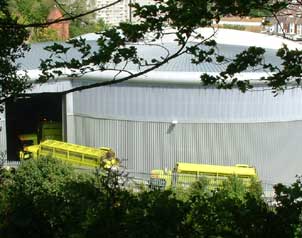
Observations of a Round Hill resident The rear of my garden faces the main entrance door of The Materials Recovery Facility. I have noticed that this door remains open for very long stretches of time, while vehicles (standing in a very long queue) wait to get in. I noticed such queues, particularly bad on Wednesday 29th April 2009. The rumbling coming through the open door has made being out in my own back garden very unpleasant. I have again had to retreat from my back garden today (Monday 11th May 2009) where I wanted to hang out clean washing. It is suitably windy today for drying washing (the historical pursuit in Round Hill), but the smell from the MRF is being carried about by the wind.
I am not alone in my discomfort, a resident living on the the south side of Princes Road, reported the nuisance earlier. She followed up her complaint on 28th April: Brother came round today and he could hear the rumbling noise I talked about. It is very intrusive.
Condition 16 of the MRF's operating conditions states that "All vehicle access doors to the Waste Transfer Station and Materials Recovery Facility shall remain closed except to enable the ingress and egress of vehicles.
However, if the doors are open for a prolonged period of time while several vehicles wait to enter, the exception in condition 16 undermines the safety and nuisance concerns which the condition is meant to address.
The vehicles queue to get in on the south side of Hollingdean Depot (nearest to Round Hill), where the Case Officer (Maria Seale) regretted that there wasn't room for any on-site landscaping. Trees and soft-landscaping would dampen the noise.
Report on noise and odour from the WTS and MRF from Round Hill resident 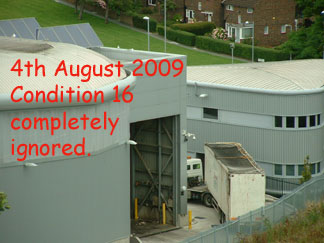
I have lived in Princes Road for 32 years. When I moved here the abattoir certainly contributed to noise. The smell of animal carcasses and disinfectant could certainly be detected by residents taking a stroll down Hollingdean Lane. However, I do not recall the odour of the abattoir carrying into Princes Road. The Waste Transfer Station and Materials Recovery Facility have proved, even in the early months of operation, to be far noisier and smellier neighbours.
On 4th August 2009, the day before my summer holiday, I photographed yet another breach of The Waste Transfer Station's operating conditions. On my return, I found a message from residents living on the south side of Princes Road, drawing my attention to the dreadful odour of rubbish in Princes Road on 11th August. The day after my return on 13th August, the whiff of stale rubbish hit me as I opened my front door. It was being carried in gusts of wind. I experienced this nuisance from several vantage points in Princes Road. Previously, I had told the Council's Environmental Health Officer that the main nuisance was noise, having only experienced isolated instances of disagreeable odour. The strength and prevalence of the smell which I experienced on 13th August have convinced me that there are two major nuisances which need to be addressed.
Related article
See Life Near The Dump - logging local residents' comments for the continued nuisance of odour from the WTS reported by Round Hill and other residents in 2010.
NEXT 10 of 11: The truth about the level of disturbance to residents